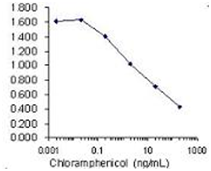聯(lián)系我們
電 話:0771-2310996
傳 真:0771-2310995
E-mail : 735565094@qq.com
技術(shù)支持E-mail: immunechem@gmail.com 備案號:桂ICP備09007987號
地 址:廣西南寧市高新技術(shù)開發(fā)區(qū)科園大道68號東盟慧谷11棟203室 530007
|
Catalog# Product Description |
CN1030 Chloramphenicol is covalently linked to HRP through acylation. Chloramphenicol-labelled HRP could be utilized for direct competitive ELISA for detection and quantization of chloramphenicol. |
|

Direct competitive inhibition ELISA using immobilized anti-chloramphenicol (3 μg/mL), and chloramphenicol-labelled HRP (100 ng/mL). 50% inhibition occurred at 50 ng/mL of free chloramphenicol under non-optimized conditions.
|
|
Formulation
|
1 mg/mL in PBS, 50% glycerol
|
||
|
Conjugation
|
Chloramphenicol-succinyl-NHS active ester, via an acylation reaction
Chloramphenicol/HRP molar ratio, approximately 3:1
|
||
|
Applications
|
ELISA
|
||
|
Scientific Description
|
Chloramphenicol is a bacteriostatic antimicrobial agent originally derived from the bacterium Streptomyces venezuelae, isolated by David Gottlieb, and introduced into clinical practice in 1949. It was the first antibiotic to be manufactured synthetically on a large scale. Chloramphenicol is effective against a wide variety of microorganisms and is still very widely used in low income countries because it is exceedingly inexpensive. Detection and quantization of chloramphenicol in food (feed) is becoming common due to the issue of antibiotic abuse.
|
||
|
Storage & Stability
|
Product is stable for several weeks at 4°C. For extended storage, store product at -20°C. Expiration date is six months from date of shipping if properly stored.
|